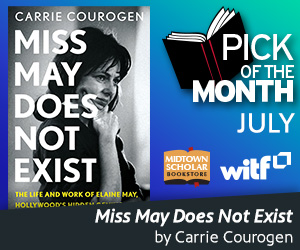Making and Re-Making Midtown

The WITF Arts and Culture Desk is launching a new series, about the changing face of the Midtown community in Harrisburg. To begin with, we take a look at two establishments that are considered something of the “founding fathers” in the area, the Broad Street Market and the Midtown Cinema.
Stuart Landon is the Director of Community engagement at the Midtown Cinema, located on Reilly Street in Harrisburg. He says that “Midtown has tipped. It is on its way to being -and is already–a place where people want to live.”
Landon has lived in Midtown for eight years and has seen a lot of changes. Now he says, “Every street corner, every intersection seems to be vibrant, and has a lot of positive energy and really cool, energetic, creative people that are moving in and helping to open up fantastic businesses.”
It hasn’t always been this way. Midtown has its share of crime and homelessness. Many who live there say that other areas of the city have higher rates of such incidents. But no one disputes the changes that are taking place.
Just a few blocks away from the Midtown Cinema is the Broad Street Market. Walking down Third Street to the Market, it’s easy to see the kind of development Landon is talking about.
Rows of vacant buildings with empty windows are just down the street from the new Susquehanna Art Museum, what was previously the vacant Keystone Bank building. More boarded up buildings with “No Trespassing” signs and graffiti on the walls are right next to trendy businesses like Bean Illustration and the Yellow Bird Café.
The corner of Verbeke and Third is occupied by the Midtown Scholar Bookstore, established by the current mayor of Harrisburg, Eric Papenfuse. It has also had a big impact on the area.
Cattycorner across Third Street is The Broad Street Market, a good place to start a series on Midtown since it was here before anything else. Founded in 1860 it fills up three city blocks with vendors.

Past the big wooden doors of the brick building, the Broad Street Market is abuzz inside with activity. People chat as they wait in line at Fisher’s Deli. Customers gaze at the pearl, jade and coral treasures of Ying’s custom jewelry. And seated at a table near Elementary Coffee is Ashlee Dugan, the former Market manager and former COO of Broad Street Market Corporation.
She tells us that the Broad Street Market was founded 150 years ago. “Two historic, beautiful market houses were built. They acted as a major food hub for the region and for the city of Harrisburg in particular. At the time, there were a few other markets in the city. But Broad Street Market is the one that has maintained and it continues to be one of the oldest continuously operating market houses in the country.”

Broad Street Market circa 1887
In 1994, the market went through a major renovation; a $2.5 million expansion brought the buildings up to modern times. But even though the Broad Street Market has been modernized, can it still be an important part of the new energy in Midtown?
Joshua Kesler thinks so. Kesler is one of the current movers and shakers in Midtown. He is the owner of the Millworks, a $2 million Midtown redevelopment project that has turned a historic building into a farm-to-table restaurant and local art studios.

Joshua Kesler
Kesler has also recently taken over as the new president of the board of the Broad Street Market Corporation. He notes that “Studies have shown that millennials spend a greater portion of their disposable income on food, and there’s a renewed interest in purchasing fresh foods to cook with.” So he feels the market is very well-positioned to take advantage.
But Joshua Kesler’s vision is for more than just the Market or even for the Millworks. He says that “The potential for Midtown as a walkable arts-focused, food-focused destination point is unmatched in the Central Pennsylvania region.”
Not all Midtown neighbors share that vision. But the fact such a vision is even possible owes a lot to a business that was launched in 2001, the Midtown Cinema.
Harrisburg Mayor Eric Papenfuse points to it as “an example of a community development project that really has paid dividends over the years.”
He says the Midtown Cinema deserves a lot of credit. ” They continue to be a sort of wonderful anchor for the community. That’s how good economic development ought to work.”

The Midtown Cinema was launched to show independent and foreign films. Todd Schill was one of the co-founders of the Midtown Cinema. Along with Allan Brown, he had a vision for establishing an independent theatre.
And, he says, the place where such a theatre made the most sense was in Midtown, “because at the time I sort of felt the community starting to grow. The coffee shop thing was just staring to explode. I saw a younger group coming in and buying homes. And we decided to look for a place here in the Midtown to help kickstart what you see today.”
Finding a suitable space was the first challenge. Schill remembers walking into the building where the cinema is housed today, “It was a blood plasma center at the time. Although the chairs were in here to give blood and some of the needles and everything were still here, it wasn’t functional”
Schill and Brown found out the building was owned by Alex Grass, the wealthy philanthropist and founder of Rite Aid. Though Schill did not know Grass, he nevertheless called him and made a pitch.
Schill remembers it this way, “I literally just picked up the phone and called Alex. and said, ‘You don’t know me, but I’m a big fan of independent cinema. You own this building. Would you give it to us to build a cinema?’ I told him the story of why I wanted to bring cinema to this area -kickstart the Midtown, launch other businesses — and he said, ‘Look. My wife is a huge independent film fan. I’ll do it just for her. So, take the building.’ “
There were more hurdles ahead — raising funds, gaining credibility from community leaders, and convincing patrons that Midtown was a safe place to come. Schill says that in the beginning, to make patrons feel comfortable in the area, the cinema had security, including extra police protection.
“I was mixed on that, ” he says. ” I don’t whether that makes you feel secure or insecure to have them here. But I think it was helpful at first.”

Stuart Landon and Todd Schill
But ultimately, things worked as he had hoped. Midtown Cinema became successful and helped create a community gathering place. Stuart Landon, who is now the theater’s director of community engagement, believes the cinema served as a catalyst for more changes in Midtown.
“It’s really changed,” says Landon. “You can walk all the way down Third Street and there’s much to do – galleries, and wonderful business that wouldn’t be here if it wasn’t for the cinema opening 14 years ago.”
The Midtown Cinema may have played a pioneering part in transforming the neighborhood, but other arts establishments would follow. In upcoming stories, we will explore some other the key developments in the Midtown arts scene. And we’ll hear from those who are not all happy about the changes taking place.


